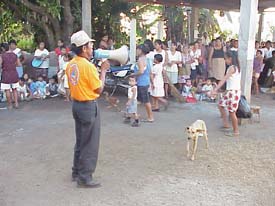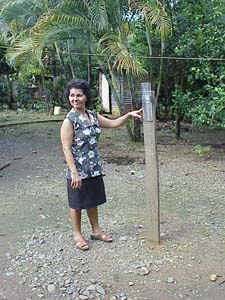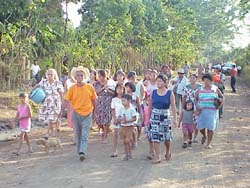|
Community-Operated
Early Warning Systems
In Central America
Juan Carlos Villagran De Leon, Department Of Applied Physics, Galileo
University
Guatemala City, Guatemala
 Central
America is a region prone to natural hazards of various kinds. Earthquakes
have devastated communities and social infrastructure throughout the countries
these past decades. Floods and hurricanes have taken their toll on coastal
plains, and volcanic eruptions and landslides have also played a role,
in more localized regions, but with lasting impacts. Central
America is a region prone to natural hazards of various kinds. Earthquakes
have devastated communities and social infrastructure throughout the countries
these past decades. Floods and hurricanes have taken their toll on coastal
plains, and volcanic eruptions and landslides have also played a role,
in more localized regions, but with lasting impacts.
As a result of the
many disasters, the Central American countries have embarked on a regionally
tailored plan to mitigate natural disasters, encompassing the creation
of national institutions devoted to the subject, funding or co-funding
projects to mitigate natural disasters, and grasping the UN Programme
for natural disaster mitigation, with CEPREDENAC (Center for Natural Disaster
Prevention of Central America) as the leading sub-regional institution
devoted to disaster prevention.
All Central American
countries now devote attention to the reduction in risks or disasters
through specific institutions devoted to this task, known as National
Emergency Councils, Civil Defense Agencies, or National Civil Protection
Institutions. Their task is to reduce the risk via mitigation, preparation,
and prevention.
Community Operated
Early Warning Systems:
 Considering
that most disasters have impacted rural areas, where climatic and hydrological
information is not yet accessible on time, simple, community-operated
early warning systems for floods have been designed and implemented in
various watersheds throughout Central America by scientist and students
of the Applied Physics Department at Galileo University. These systems
are based on these standard, but simple actions: Measure rainfall, Measure
river levels, Determine if floods are possible via simple protocols and
Execute emergency plans if floods are possible Considering
that most disasters have impacted rural areas, where climatic and hydrological
information is not yet accessible on time, simple, community-operated
early warning systems for floods have been designed and implemented in
various watersheds throughout Central America by scientist and students
of the Applied Physics Department at Galileo University. These systems
are based on these standard, but simple actions: Measure rainfall, Measure
river levels, Determine if floods are possible via simple protocols and
Execute emergency plans if floods are possible
These systems are
set up using a standard radio network to link the various voluntary observers
throughout the watershed with authorities and volunteers in the flood-prone
communities. The observers located throughout the watershed measure and
transmit rainfall and river level data to a local center where the data
is analyzed and a forecast is made concerning probable floods. This center
then transmits via the same radio network the information to the communities
in the flood plains and to local authorities.
Technical Designs
of the Early Warning Systems
These community-operated
early warning systems have been designed with several criteria in mind:
- Instrumentation
supplied to the observers must be simple and practical, so that people
with minimal education can use it effectively.
- The instrumentation
to be implemented must be replaceable on a quickly basis and at a reasonable
cost, so than the system can work on a continuous basis.
- The instrumentation
to be implemented must contemplate the use of standard batteries as
a main source, or at least as a back-up mechanism, as during major floods
electrical power outages can be common.
Rainfall is measured
with standard, plastic rain-gauges (Tru-Check brand gauges, 6 in. capacity),
river level is measured via a simple, electronic instruments which display
the level of the river in digital fashion (one digit from 0 – 9 indicating
the various levels) with an audible alarm adapted for the case of floods
occurring late at night (developed and constructed by personnel of the
Applied Physics Department).
With these ideas in
mind, early warning systems are implemented via a sequence of phases,
which can be grouped into two components: a technical component dedicated
to instrumentation and the measurement of weather conditions for the forecasting
of floods, and a social component dedicated to the set up of the communal
organization required to ensure that the early warning system will be
operated properly. Both components can be organized in phases.
The technical component
can be organized as follows:
Phase 1: research
on the local historical weather conditions, to determine return periods
for floods, amount of rainfall required to flood communities, and determination
of river levels associated with floods at various points throughout the
watershed.
Phase 2: visits to the watershed to determine optimal points to measure
rainfall and river levels, which contemplate both hydrological conditions,
as well as potential operators of the instruments.
Phase 3: acquisition and deployment of instrumentation in the selected
sites.
Phase 4: testing and calibration of the instrumentation.
In contrast, the social
component must be organized according to rules and regulations dictated
by municipal authorities, as well as by national disaster reduction institutions.
In general, these institutions are responsible for the safety and well
being of the population, and thus, must be included in the various activities
related to the early warning system. Several phases can be pointed out:
Phase 1: coordination
between the national disaster reduction institution, municipal leaders
and volunteers to implement the system in a coordinated fashion.
Phase 2: set-up of committees to execute the various tasks involved, such
as training, community organization and emergency response.
Phase 3: implementation of workshops to train committee members on the
specific instances related to the operation of the early warning system.
Phase 4: implementation of strategies to convey information to the general
public in relation to the system, and to foster relations with members
of the community to generate a social awareness about the early warning
system and its virtues.
Phase 5: involvement of community leaders and members of the community
in various committees related to emergency planning.
Phase 6: implementation of workshops to train community members in the
various tasks required to complete the early warning system, such as hazard
and vulnerability mapping, emergency planning and coordination, posting
of evacuation routes, search and rescue activities, shelter implementation
and management, crisis management, and interinstitutional coordination.
Phase 7: testing of the system via simulations and tests.
 In
general deputies of the national and municipal emergency committees carry
out these phases, as they possess the knowledge and experience to execute
the related activities. In contrast, the technical component can be implemented
by technical consultants, supported by technical personnel of the national
emergency committee to ensure that guidelines are being followed with
respect to system operation. The various systems throughout Central America
have been set up within a period of six to eight months to ensure the
all phases are carried out. Additionally, the involvement of the national
disaster reduction agency has been a key point to promote local sustainability. In
general deputies of the national and municipal emergency committees carry
out these phases, as they possess the knowledge and experience to execute
the related activities. In contrast, the technical component can be implemented
by technical consultants, supported by technical personnel of the national
emergency committee to ensure that guidelines are being followed with
respect to system operation. The various systems throughout Central America
have been set up within a period of six to eight months to ensure the
all phases are carried out. Additionally, the involvement of the national
disaster reduction agency has been a key point to promote local sustainability.
Initial Results:
Systems of this type
have been implemented in Guatemala in six watersheds, in Honduras in three
watersheds, and in individual watersheds in Costa Rica, El Salvador, and
Panama. Funding for these systems has been provided by ECHO (European
Community Humanitarian Office), SIDA (Swedish International Development
Agency), OAS (Organization of American States), and via government loans
(Guatemala).
Among the various
lessons to be learned from these experiences, the following deserve special
consideration:
- Community-operated
early warning systems are providing information concerning river floods
to local authorities and to members of the communities on a daily basis.
- Community-operated
early warning systems tailor-made taking into account social and cultural
conditions of the local population have been readily accepted and operated
by members of the community.
- Community-operated
early warning systems have provided communications in cases of emergencies
not related to floods, because the communication network is readily
accessible to the communities. In this respect, the linking with the
national disaster reduction agency aids communities in solving social
problems of various kinds.
- Community-operated
early warning systems are easier to set up and maintain than costly
telemetric systems.
Conclusions:
Community-operated
early warning systems are offering local authorities in flood-prone communities
an alternative to the national, centralized weather information systems.
This alternative is fostering community involvement, and is creating an
awareness about the possibility of addressing local problems with local
solutions and local involvement.
The extreme simplicity
of these systems makes it easy to be applied in typical watersheds of
small dimensions throughout Central America (watersheds encompassing a
few thousand square kilometers at most).
These systems are also providing a platform for the future implementation
of prevention and mitigation measures in a process called risk-reduction
management. This innovative process is being set-up within the national
institutions devoted to civil defense in case of natural disasters and
will soon be implemented in rural areas.
Further information can be requested at the following address:
Departemento de Física Aplicada
7ª Avenida Final, Zona 10
Guatemala City, Guatemala
Central America
Tels: (502) 331-4948, 360-3531, 360-3541, 360-3551
Fax: (502) 331-1645
jcvilla@galileo.edu
jcv_conred@hotmail.com
|

